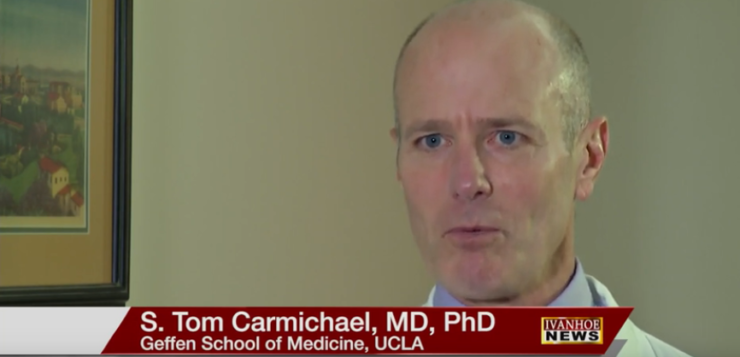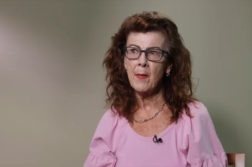S. Tom Carmichael, MD, PhD, Prof/Chair of Neurology at the Geffen School of Medicine, UCLA talks about strokes and a gene that could affect recovery.
Interview conducted by Ivanhoe Broadcast News in December 2018.
We’re talking about recovery from mild stroke. Tell us about how you got to where you’re going to launch that clinical trial with the walker.
CARMICHAEL: Stroke is the leading cause of adult disability and yet there is no medical therapy to promote recovery in stroke. And that’s primarily because of the brain’s limited capacity to repair. It’s not like the liver or the skin. And this has really vexed modern medicine for a long time. The only therapies we have that enhance recovery are physical therapy, occupational therapy or speech therapy. We’ve been very interested in neurology and trying to understand how the brain does repair because everyone gets a little better from stroke. And how we might enhance that for a more complete recovery. And one of the things we recognize in stroke patients is when they start to recover, the mechanisms that they use look a lot like the same things we used to memorize something or to learn something. When somebody learns a golf swing or a tennis swing some of the same things they do to learn that appear to be how the body recovers after stroke. We wanted to explore this parallel between normal learning and recovery from stroke. Are memory systems in the brain useful if we could stimulate them to enhance recovery after stroke? To do this, we started a series of studies in my lab to characterize molecular molecules that enhance memory to see if they may also facilitate recovery in stroke. And that led to the discovery of this gene CCR5 that normally blocks recovery in stroke. When you turn that gene down you enhance recovery.
Why is it blocked?
CARMICHAEL: That’s a good question. It seems that the body has a number of systems that it activates that limit the initial stroke damage. They decrease how excitable the brain is initially and that decreases the spread of the original stroke damage. The problem is these things that appear designed to limit stroke damage persist and over the long term limit recovery.
Interesting. Tell us about the study in Israel.
CARMICHAEL: What we started with were studies in laboratory mice, which showed that we could give a drug that blocked the CCR5 receptor and this enhanced recovery in mice. And we understood the mechanism was that it helped form new connections in the brain after stroke. One of the interesting translational things here is that this receptor, though it has a role in stroke, it’s better known as the receptor for the AIDS virus. There is a large literature out there on CCR5 in HIV infection. And as part of that literature, we know that about 13 percent of Europeans have a mutation in this receptor and it limits, of course, their ability to get AIDS. But we wondered, does it also improve their recovery in stroke? We had to collaborate with groups that might have a larger percentage of these patients in an ongoing stroke study. And one thing we do know is that patients who have an Ashkenazi Jewish origin also have a high percentage of a mutation in this receptor. In this Tel Aviv stroke study the researchers happened to have two things, a large percentage of patients of Ashkenazi Jewish origin and blood in the freezer. These blood samples allowed the researchers to determine the status of the CCR5 gene—did it have this mutation in subjects in this stroke study. This was an ongoing study but we could test that blood to see who had the mutation and who didn’t.
And what did you find in that study?
CARMICHAEL: We found that patients with partial knockout of this CCR5 receptor recovered better after stroke than patients without this mutation. This is the first description of a human gene that “codes” for recovery after stroke.
That’s fantastic. So basically, people who didn’t have the gene recovered better?
CARMICHAEL: Right. It’s kind of a flip. I say “codes” for recovery in stroke. But if this gene is knocked out in humans, those patients get better than if they didn’t have that knockout.
Very cool. We’re talking about repurposing HIV drugs to help patients. Just elaborate on that a little bit. It’s kind of awesome.
CARMICHAEL: Science can move slowly, especially when you really want itto move fast. In stroke recovery, we clearly do. There’s a long translation from discovery in a lab to application in the clinic. But in this case there is an AIDS drug already out there that blocks CCR5, and about 15 percent of AIDS patients are on it. We know it’s safe. We knew that we could test it to see if it enhances recovery. So we actually started the clinical trial for this way before we even published.
So you’re already in trial.
CARMICHAEL: Yes we are. We have a trial sites at Yale, Burke and UCLA.
What’s the name of the drug?
CARMICHAEL: The drug’s called Maraviroc.
And when did the trial start?
CARMICHAEL: We have had the approvals for about a year and a half ago. There were a number of operational hurdles. The trial is really just starting to ramp up now
You’re still enrolling patients?
CARMICHAEL: Yes.
It’s way too early to see if it’s working?
CARMICHAEL: Yes we have no data–no signature of response yet–to understand.
What is your hope for this drug? How effective can it be in recovery?
CARMICHAEL: Those are good questions. This drug obviously is developed to treat HIV infection so it was not optimized to gain access to the brain. The brain has a barrier that prevents a lot of drugs from getting in from the blood stream. And this drug wasn’t designed to necessarily get more easily through that blood-brain barrier. This could be a problem. Because it was tuned or optimized as a drug for HIV infection it may have limits in what it can do in the brain. Our hope is that it does enhance recovery, even if this recovery enhancement is modest. As many stroke patients know, there is a possibility that if you can just enhance recovery a little bit or increase brain plasticity modestly with a drug, you may then be able to do more with a very aggressive rehabilitation program that is paired with this drug..
How do you get it to patients?
CARMICHAEL: It’s an oral medication.
This has to bring so much hope for patients who haven’t had medical help in recovery ever.
CARMICHAEL: We hope so. It’s tempered hope. But it’s a pathway. And we haven’t had a lot of those.
What haven’t I asked you about this research?
CARMICHAEL: I think the public would do well to understand that these studies started out with an idea about molecular memory systems and their role in recovery and required a lot of laboratory bench testing. Besides the CCR5 molecule that we have discussed today, my lab and others have tested many different molecules and approaches. Not all of them have let to clinical trials. There is a lot of necessary work in the lab that sets the stage for the one thing that might get through the hurdles and limitations to make it into the clinic. For CCR5 blockade, many things came together at the very end to make it more relevant for a human therapy. However, it was really basic research that led this to go forward.
In the mouse model how much recovery did the mice make?
CARMICHAEL: The mice made about 30 to 50 percent enhanced recovery. We know in humans with movement or motor recovery that if you get a 10 percent improvement in motor function, this actually translates to a meaningful change in your interaction with the community. This is what is known as a minimal clinically important difference or MCID. It’s about a 10 percent improvement in some movement scales or rating scales in humans. The mouse recovery was far better than this MCID, and it allows us some hope that it was a meaningful thing we hit in the mouse.
Do most stroke patients make that 10 percent?
CARMICHAEL: Most stroke patients will recover. It depends on their initial severity, and most stroke patients recover a certain percentage from this initial severity. This percent recovery is about 70%: stroke patients will recover about 70% from their initial stroke deficit. If a stroke patient has a really severe stroke, they’ll get a predicted recovery level of about 70 percent. But when this initial effect from stroke is severe, this 70% recovery doesn’t get them back into independence.
What are some things that would help you recover from a stroke?
CARMICHAEL: That question assumes a person has had a stroke and been hospitalized. Now they are discharged. At present, the main thing the patient can do is stay active and engaged with the deficits that they have, so that the patient exercises them and repetitively uses them. For example, if a patient is having trouble with reach and grasp of the arm, the key is to not let that arm dangle and open the peanut butter jar just with the good hand, but to actively engage and try to use the affected hand in meaningful tasks. The same applies with gait or balance or speech.
Are there any exercises that you should do or shouldn’t do to help with recovery?
CARMICHAEL: The fundamental thing is that really no exercise is bad. Many stroke patients will go home and engage in less and less activity—spending more time on the couch. As a result stroke patients actually lose function even though their stroke was way back, they may get worse at home because they’re inactive. So the first answer is there is really no activity that’s bad. There are a certain few things that may think may make things arm or leg function worse after stroke. This is when patients strengthen some of the muscles or muscle movements that are preserved. We all have an image of a stroke patients who might have a kind of a curved or flexed-in arm. I’ve had patients who will do a lot of arm curls with weights. This is actually the wrong thing to strengthen because there’s a natural mismatch in arm flexion vs arm extension, and one would not want to selectively strengthen arm flexion, such as with biceps curls. However, this is pretty uncommon. The main thing is the more activity, the better.
Is there anything that would actually slow stroke recovery?
CARMICHAEL: Inactivity is the main thing. If a stroke survivor went home and were to be inactive and not use the affected functions, this would slow stroke recovery.
END OF INTERVIEW
This information is intended for additional research purposes only. It is not to be used as a prescription or advice from Ivanhoe Broadcast News, Inc. or any medical professional interviewed. Ivanhoe Broadcast News, Inc. assumes no responsibility for the depth or accuracy of physician statements. Procedures or medicines apply to different people and medical factors; always consult your physician on medical matters.
If you would like more information, please contact:
Elaine Schmidt
310-267-8323
Sign up for a free weekly e-mail on Medical Breakthroughs called First to Know by clicking here




